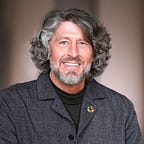Mark Shepard on Inside Ideas
How to invest in farming and nature
Mark Shepard, who leads one of America’s most ambitious sustainable agriculture projects — New Forest Farm — is my guest today on Inside Ideas.
New Forest Farm is a planned conversion of a typical row-crops grain farm into a commercial-scale, perennial agricultural ecosystem using oak savanna, successional brushland and eastern woodlands as the ecological models. Trees, shrubs, vines, canes, perennial plants and fungi are planted in association with one another to produce food -for humans and animals — fuel, medicines, and beauty. Hazelnuts, chestnuts, walnuts and various fruits are the primary woody crops, and the farm is entirely solar and wind powered, with the farm equipment powered by locally produced biofuels.
It is one of the country’s most impressive agriculture systems and Shepard, CEO of Forest Agriculture Enterprises, and the award-winning author of the book: Restoration Agriculture: Real-World Permaculture for Farmers, wants to see more of it.
“Restoration agriculture is more like describing a process than a prescription. It’s not do this, do that, more: these are the ecological principles that we’re working with, this is how this seems to work in this area, if it’s hot, cold, dry, wet, all of those things affect how the system will work,” he said. “It is also a little bit more deliberate than a rewilding in that we intentionally set up the ecological ecosystem that’s native to the area. We use genetics that have already been improved for yield, pest and disease resistance, and then arrange them in orderly patterns based on managing the rainfall and potential run-off that will hit the site.”
He added: “So our interactions with the system more closely mimic the natural disturbances that would manage and maintain those systems in the wild. So we try to mimic fire, we mimic grazing, that sort of thing. It is a little bit more deliberate and intentional than a rewilding. But similar principles apply, in that once we set up the system, it’s a semi-natural system.”
It is a system, he says, that quickly brings out all the ‘surviving critters and legacy organisms’.
“On 4 July I got to walk along on the opposite side of a row of trees from two young badgers and I called them to me, which was curious. I didn’t expect that I would be calling badgers to me and they were so curious they came up to me and made these really neat little purring sounds — now, where do you get that in a wheat field? You don’t. But I get some of these magical moments that happen almost all the time because we’ve set up a system where we all can live abundantly.”
Fortunately the animals weren’t muttering the word regenerative, as that might have taken the shine off that magical moment.
“I’m going to slap regenerative right in the face,” he said. “The term regeneration has had a meaning in biology, in forestry, in ecology, in botany for 400 years. It has been researched by PHds, and it is the ability of an individual, a community type, or an ecosystem to reproduce itself on the site, the way it is with the natural forces: the wind, the rain, the storms, the fires. All of the disturbances that nature can throw at it, it will still resprout and regrow and expand its population — so there is no regenerative broccoli farm out there. If you go and wipe out that broccoli crop it does not regenerate, so it fails the ultimate test of regeneration — it has to be able to regenerate itself, grow and expand its populations and the only thing that I know that does that, are natural ecosystems and so that’s why I’m once again investing in nature.”
But Shepard, the founder of Restoration Agriculture Development, says any investment in nature will need to be managed properly.
“As we restore ecosystems around the world and as we create semi-natural systems that produce tons of food, we will find that all of the horrible bad, mean animals that our ancestors shot and killed, their populations will start doing better. And modern humans will all of a sudden have a similar problem in the opposite direction,” he said. “Now that we are restoring all this habitat we are having larger populations of coyotes, of wolves. The wolf population in Wisconsin is expanding. There are larger populations of bears. Have you ever tried to raise honey bees when you have bears around? It brings up a whole new host of techniques. We will have to learn in order to protect what is ours and yet co-exist with what is rightfully theirs.”
Finding this balance, this symbiosis with nature, is critical and I am delighted to welcome Mark Shepard on to the show to discuss how we can best achieve it.
Article from INNOVATORS MAGAZINE.
Get a deep dive on inside ideas from global thought leaders, sign up for our ‘Innovate Now’ newsletter to get episodes straight to your inbox.
Watch and subscribe to Inside Ideas on YouTube, listen wherever you get your podcast, and follow the show on Instagram, Facebook, LinkedIn, Innovators magazine, and Apple News.
